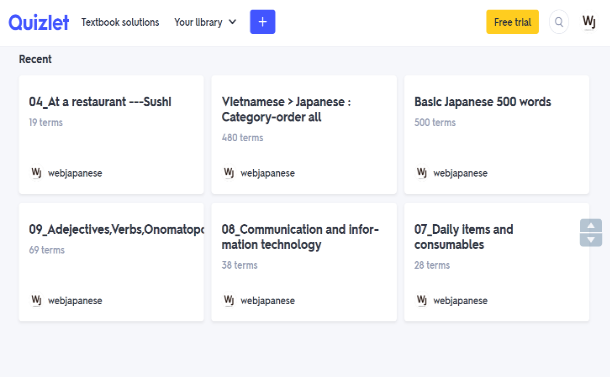日本語三部作 / Foreign Language books < Minimum Japanese
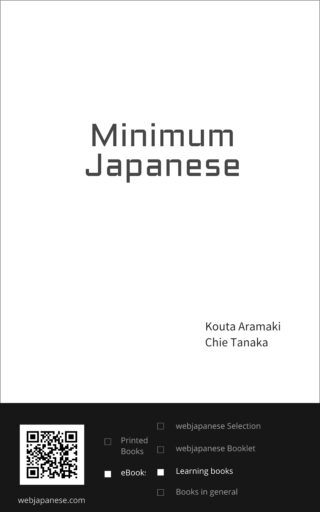
Minimum Japanese
The definitive version of Japanese conversation guide for tourists, created by Japanese teachers.
All you need to do is to understand 10 short sentence structures. By adding vocabularies to them, you can speak natural Japanese like a native speaker.
Over 500 basic vocabulary such as “jidori (selfie)” “korona (covid-19)” and “suihanki (rice cooker)” with 600 audio files. Just go over the QR codes in the chapter and hear what they sound like!
[日本語の説明はこのページの下のほうにあります]
eBooks $7.99 / 1580 yen
Amazon.jp◇ Now available at Amazon: U.S. | the United Kingdom| Germany| France | Spain | Italy | Nederland、 | Canada | Brazil | Mexico | India | Japan |
Printed books $9.99 / 1800 yen
Amazon.jp◇ Now available at Amazon: U.S. | the United Kingdom | Germany | France | Spain | Italy | Nederland | Poland| Sweden| Canada| Australia|
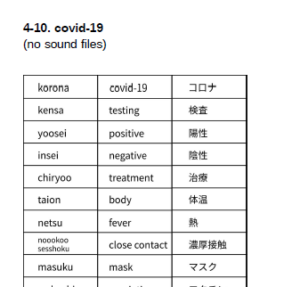
A must-have portable conversation handbook for those of you visiting Japan, either for tourism or business. We have made drastic changes to our bestselling 7days 60minutes to create this new enriched version titled Minimum Japanese.
You can acquire more expressions with the same amount of time as the previous book. We also added QR codes so that you can listen to its pronunciation using your smartphones.
The book is rich with useful information such as how to count numbers in Japanese, guide for pronouncing Japanese names and hints on English pronunciation used in Japan.
We also have an abundant vocabulary list of Japanese words for food and souvenirs which will be useful during your stay. Over 500 vocabularies have their own QR codes inside the book to help you with the pronunciation just by using your smartphone. Not only words such as “jidori (selfie) ” and “suihanki (rice cooker)” are there but Japanese pronunciation for words like “Instagram” will also be there for you to know how they are pronounced in Japanese.
Minimum Japanese is the ultimate studying method acquired by a long time pursuit of Japanese teachers, who have been teaching Japanese to short-term visitors, on how to acquire the most of Japanese conversation skills with the least amount of effort.
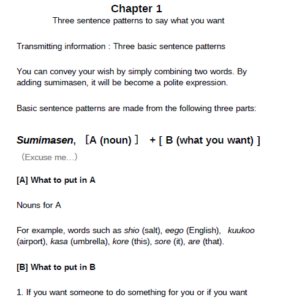
First, we take a look at 3 simple sentence forms. All sentences will use only one noun and short phrases such as “nantoka (please)”. In order to diversify this single expression, we added words such as “onegaishimasu (please)” and dekimasuka (can you?)”. In just 3 variations, you will be able to express your basic wish at hotels, restaurants and tourist sites. All phrases in the book are natural expressions which are used by native speakers. They are also in polite forms so you don’t need to worry about upsetting anyone.
We will also introduce you to other short sentence patterns and their 7 variations. Once you have learned this 10 or so phrases, all you need to do is to add nouns such as restroom, selfie, ramen (Japanese noodle) etc. Possible responses to your question will also be available in audio file formats.
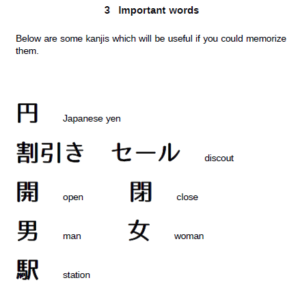
Also in the revised version, Minimum Japanese, we look into several expressions using adjectives and verbs. This will enable you to express your opinion when you have eaten something or when you have seen a scenery or even ask someone out for dinner.
Free Vocabulary Downloadable list
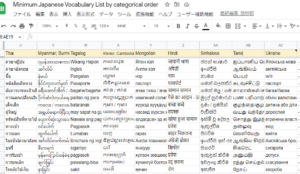
> Japanese, English, Spaish, French, Portuguese, German, Italian, Dutch, Russian, Turkish, Arabic, Vietnamese, Indonesian language, Nepali, Simplified chinese, Traditional Chinese, Korean, Thai, Myanmar; Burmese, Tagalog, Khmer; Cambodian, Mongolian, Hindi,(Languages other than English are automatically translated by Google Translate.)
We believe that this book will give you all the necessary information whether you are short-term visitor for tourism or business. If you can correctly understand all these expressions, you will be able to properly communicate with the Japanese people around you.
- 3 extremely short basic sentence forms to convey your basic needs
- 4 sentence forms to acquire information from your listener
- 3 more sentence forms to solve your problems
- And last but not least, we look into ways of using adjectives and verbs to express your idea and to ask someone out for dinner.
👉 If you are interested in speaking Japanese, please use this book as your starting point. Once you have basic knowledge and would like to learn more, please try our entry level Japanese instruction book, Nihongo.
Authors
Kouta Aramaki
BA in Japanese literature
I’m a freelance Japanese teacher and I’ve been teaching Japanese mainly in Tokyo since 1993.
I’ve also been making a website for Japanese learners, webjapanese.com since 1998.
Chie Tanaka
Working as a Japanese teacher since 2008.
Currently in charge of operation and publishing through the internet, while simultaneously teaching at Sabaragamuwa University of Sri Lanka.
Translator
Shoko Natori
Introduction
Local rules for this book
Several points you need to be careful about
Chapter 1 Transmitting information: Three basic sentence patterns
1. ONEGAISHIMASU
When you want the listener to do something for you.
2. ARIMASUKA
When you want to know whether the listener possesses
something or if something exists.
1. DEKIMASUKA
When you want to know if the listener is capable of doing
something.
Chapter 2. Receiving information
1. Various replies which can be predicted
2. I beg your pardon?
3. Receiving infromation
Asking for a price
Asking for a destination of a train or a bus
Obtaining one’s approval
Chapter 3. Expanding your expression
1. Greetings and useful phrases
2. Need help?
3. Basic rules about numbers
Chapter 4. Further expanding your expression: adjectives and verbs
1. Adjectives that convey your feelings
2. Let’s use some verbs
Chapter 5. Summary and conversation examples
1. Sentence patterns
2. Conversation examples
Appendix
1. List of Japanese syllables
2. Useful facts about numbers
3. Important kanji
4. Vocabulary list by category
5. Vocabulary list in alphabetical order
About QRcode reader
👉 QRcode.com|DENSO WAVE | Japanese | English | Chinese | Korean | App |
1) mp3 file archibe
Here is a list of all the words and sound-files.
2) Downloadable list
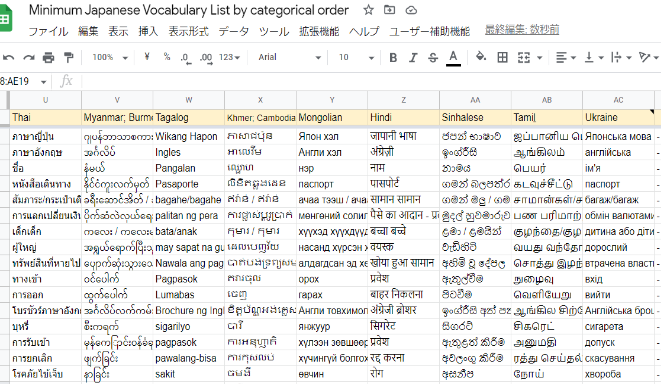
Minimum Japanese Vocabulary List by alphabetic order
Minimum Japanese Vocabulary List by categorical order
👉 > Japanese, English, Spaish, French, Portuguese, German, Italian, Dutch, Russian, Turkish, Arabic, Vietnamese, Indonesian language, Nepali, Simplified chinese, Traditional Chinese, Korean, Thai, Myanmar; Burmese, Tagalog, Khmer; Cambodian, Mongolian, Hindi,(Languages other than English are automatically translated by Google Translate.)
2) Learn with Quizlet
You can learn words with Quizlet.
日本に来る予定で日本語のことを知らない人がいたらお勧めしてください。日本だけでなく、各国のアマゾンストアで電子書籍と印刷版の本を買うことができます。このページの一番上に各ストアへのリンクがあります。
■ どういう本?
Minimum Japanese(以降 MJ)は、日本に観光や短期滞在で来る日本語が話せない人のための本です。著者は90年代から関東で英語圏のビジネス関係者や英会話教師の人達に日本語を教えてきた(有資格の)日本語教師です。
英語で書かれていますが、可能なかぎり易しい英語になっていますので、母国の義務教育で英語を学んだ人(欧州、南米、アジアアフリカ、ほとんどの国で英語は勉強することになってます)なら理解できると思います。
このMinimum Japaneseは、2011年に発売し、2012年に米アマゾンで日本語部門で1位になった「7 days 60minutes Japanese」という本の増補改訂版の第2版です。星評価はほぼ5で、2年間にわたってベスト10を行ったり来たりでした。ちょうどこの本の初版出版する時に東日本大震災が起こりました。東北の風評被害が問題になったので、東北の地名をたくさん入れました。以来、1冊売れるごとに10円を2030年まで毎年震災で親を失った子供の教育資金として寄付することにしています(こちらで毎年報告をしています)。
この第2版は2022年の6月10日にコロナ後に始めて観光客の受け入れを再開した日が出版日です。また何か力になれればうれしいです。
■ 価格
価格は電子書籍が、ドル、ポンド、ユーロともに4.99ドルで500円。印刷版はドル、ポンド、ユーロともに7.99で、1200円と私どもの書籍では最も安い部類です。
→ 第2版出版記念で、2022年7月末まで観光再開記念で 電子版は $£€2.99 300円。印刷版は$£€4.99で980円です。
■ この本の考え方
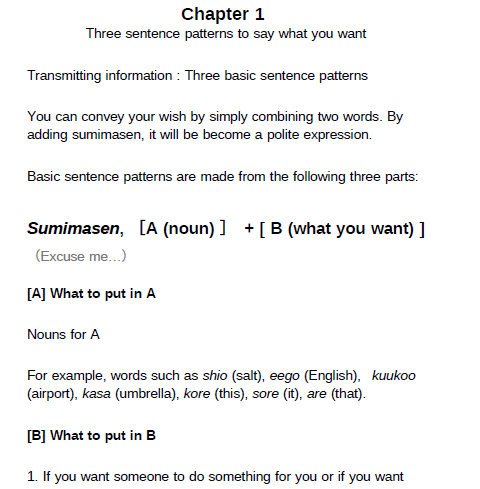
最小の学習で最大の効果がテーマです。軸になる考え方は、文を覚えるのではなく、文を作るというものです。従来の観光用の会話集やサバイバル日本語の本では、丁寧で無難な決まり文句、例えば
ワインリストを持ってきて下さい。
とか、礼儀正しい日本人相手だし、とか高級レストランでも大丈夫なように、と
ワインリストを持ってきていただけますか?
などという例文がずらずらと書いてあり、それを覚えて言えばいい、というものが多かったのですが、私達は日本語教師でもありますので、より合理的に、効率的に
[ 名詞 ] + おねがいします
の名詞のところに名詞をいろいろ入れれば大丈夫。というふうになっています。つまり
ワインリスト おねがいします
で十分だという考え方です。これは一見、外国人向けのサバイバルフレーズのようですが、実はほとんどの日本人もこんなものですし、自然で十分丁寧な表現になっています。実は、ほとんどのあまり勉強が得意でない長期滞在者も、ここの本にある知識でなんとかサバイバルしています。
しかも、この構文を覚えれば、かなりいろんなことが言えますし、レストランやホテルの受け付けや買い物などのような話題が決まっている場面では、だいたい相手に必要なことは伝えられます。
基本は3つだけで、名詞と + おねがいします。できますか ありますかの 3パターンです。おねがいしますは、万能ですが、ありますかは、モノだけでなく両替などのサービスがあるか?でも使えますし、できますか?は、あなたが(英語とか)できるか? でも使えるし、私が(充電とか撮影とか)できるか?でも使えます。より細かい使い分けがだんだん出来るようになります。
もちろん、相手の返事についても、いくつかに分類して解説しています。
ここまででも大丈夫だけですが、と、さらに、名詞+ どこですか、いきますか、いくらですか、ありません、いません、の他に、食べられません、トイレが壊れてます、などいろんな時に便利に使える「名詞+だめ(+です)」も3つの使い分けを紹介してます。
病気の際の「名詞 が いたい」や、アレルギーです という表現も入れました。
形容詞で、気持ちを表現したい、伝えたい!という人は結構いますから。
寒いですねえ
みたいなことも言えるようなパターンも用意しました。
たべる?
たべる、たべる!
なんてカジュアルな応用も少し書いてます。
あと数字も少し説明しています。結構大事ですからね。
数字は、英語圏と切り分ける位が違ったりしますし、その他、数字は言語によってかなり違う(フランス語とか…)ので、丁寧に書きました。
■ 音声ファイルと語彙リスト
紹介できる名詞は数に限りがありますが、500ぐらい紹介してます。ゲイ、トランスジェンダー、オストメイト、インスタ、自撮り、などなどすべて音声ファイルがあります。そしてもちろん、2022年に出版する本ですから、コロナ関連なども新たに追加しました。
組み合わせでもっと増やせるということも書きました。例えば、国名+ じん せい りょうり で、名詞が作れるよ、とか、キリキリ、ズキズキ、どきどき、などのオノマトペ。もし、余裕があるなら、と、形容詞と動詞もちょっとだけ紹介しています。
もちろん、翻訳サイトやアプリなどもQRコードで紹介しています。すべての例文の音声ファイルもあります
音声ファイルと、語彙のリストはここからダウンロードできます。 ライセンスは下のリストも含め、CC BY SAです。
以下は、ダウンロードできるリストへのリンクです。ウェブでも見ることができます。
Minimum Japanese Vocabulary List by alphabetic order
Minimum Japanese Vocabulary List by categorical order
Google翻訳とみらい翻訳で作ったものですが、ウクライナ語を含む25言語の語彙のリストをGoogleスプレッドシートで公開&配布しています。(英西仏葡独伊蘭露、トルコ、アラビア語、ベトナム語、インドネシア語、ネパール語、中国語(簡体字、繁体字)、韓国語、タイ語、ミャンマー語、タガログ語、クメール語、モンゴル語、ヒンディー語、シンハラ語、タミル語、ウクライナ語)
この語彙は、Quizletで遊びながら覚えることもできます。すべて無料なので、実は、観光客の方々だけでなく、日本に滞在していて、日本語の勉強が苦手だという人にも役に立つと思います。実はこの本の日本語は、語学が苦手な外国人滞在者が自然と身につけた典型的なサバイバル表現を、日本語教師の視点で分析、整理し、再構成したものですから、無理なく覚えられ、実用的であることはすでに保証済み、というわけです。この本くらいの知識で2年、3年と生活している人は結構います。
130ページくらいですが、本編は70ページくらいです。多分、日本に来る飛行機の中で読み終えることができます。日本に来るという人、日本に住んでいて日本語ができなくて困っているお知り合いがいましたら、勧めていただけるとうれしいです。
以下は、日本語の説明をまとめたPDFと画像とQRコードです。SNS投稿に最適化したサイズですが大きめなので右クリックでダウンロードしてください。中身を改変しなければリサイズして自由に使うことができます。
👉 まとめてのご注文に応じるのは難しいのですが、その分安くなっていますので、アマゾンでお買い求めください。
👉 ただ日本で長く生活するとなると、やっぱり、「お客さん」ではなくなってきて、聞く能力も大事になってきますし、もうちょっと勉強したほうがいいと思います。私たちのサポートサイトのおまけの日本語教師読本Wikiも参考にしてみてください。


